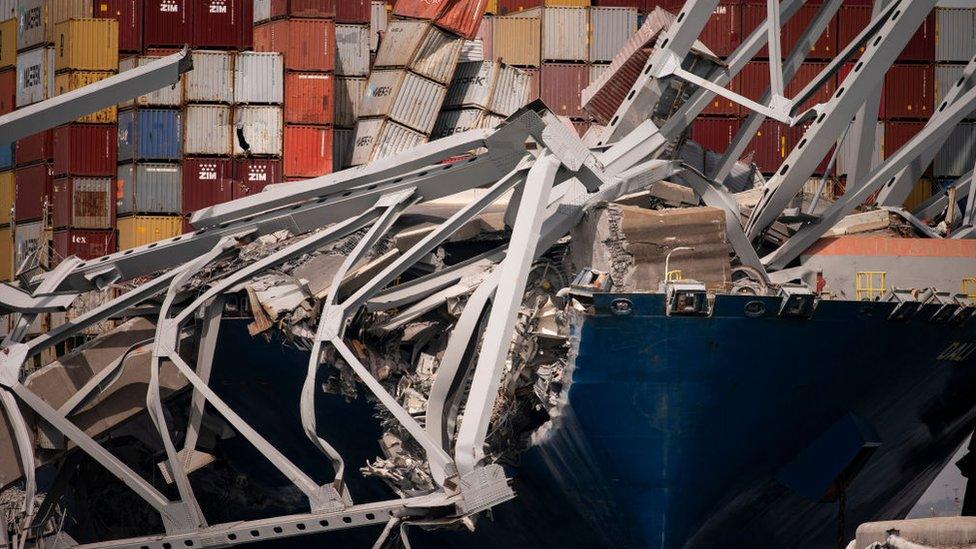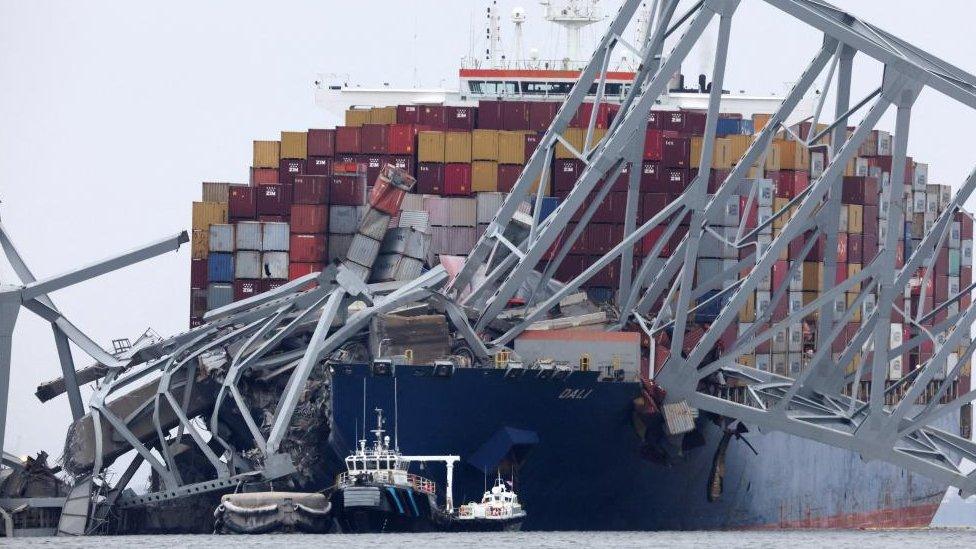Baltimore bridge: Massive US crane to haul wreckage after deadly collapse
- Published
Watch: New drone video shows close-up view of debris from the Baltimore bridge collapse
The largest crane on the eastern US seaboard has arrived in Baltimore as part of a massive clean-up effort after the Francis Scott Key Bridge collapse.
Shipments in and out of one of the country's busiest ports are suspended while the wreckage hangs over the cargo ship that crashed into it.
The search for the bodies of four workers remains on hold because of the dangers of diving amongst the wreckage.
Some $60m (£48m) in federal emergency funds will go towards recovery efforts.
President Joe Biden said he is headed to Baltimore next week to view the crash's fallout and speak to federal efforts.
The port is a main economic generator for the state of Maryland and a vital artery for imports and exports of US and global trade.
Eight construction workers were repairing potholes on the Key Bridge early on Tuesday when the Dali container ship veered into one of its columns, sending most of the structure crashing into the water.
Two were rescued. The bodies of two others were recovered and the remaining four are presumed dead.
Sonar scans indicate the vehicles that fell into the water are encased in a "superstructure" of concrete and other debris, say state police.
Maryland Governor Wes Moore said each stage of the recovery and salvage operation would be difficult.
Watch: A view from inside the ship that hit a Baltimore bridge
"We're talking 3,000 to 4,000 tons of steel that's sitting on that ship," Mr Moore told reporters on Thursday.
The Dali container vessel - which is nearly as long as the Eiffel tower - remains on the water. Its 22-person crew, all Indian nationals, are reportedly still aboard.
The recovery has been further complicated by the amount of debris in the dark waters of the Patapsco River. Divers have been unable to see more than a foot or two in front of them.
The effort will be paid for by the US Army Corps of Engineers, which is sending several officials to oversee the efforts. US Navy contractors will also join the efforts, and they will be joined by more than 1,100 engineering specialists.
Watch: Crane arrives to clear Baltimore bridge wreckage
The largest crane on the eastern US seaboard, which can lift 1,000 tons, is being erected at the site on Friday. The crane, called the Chesapeake 1000, was built in 1972 and is 191 feet (58 metres) long. It will be followed by a smaller crane on Saturday.
Those involved in the operation must figure out how to cut debris from the bridge into pieces so they can be lifted by the crane, officials said.
It must be done carefully to ensure none of the hazardous material held in shipping containers atop the Dali spills into the river.
Some of those containers stored sheen, which is used in paint. A few have already broken open, the National Transportation Safety Board (NTSB) has said.
Authorities have deployed floating booms in an effort to corral any leaks.
Experts estimate it could take a month for the Port of Baltimore to reopen and years to rebuild the bridge. The incident investigation may take two years.
People in Baltimore are still reeling from the disaster.
The city's Major League Baseball team, the Baltimore Orioles, marked the start of their season on Thursday with a moment of silence for the victims, who were from El Salvador, Guatemala, Honduras and Mexico.
The wife of one of the construction workers who was pulled from the water said it is a miracle that he is alive as he does not know how to swim.
Julio Cervantes' spouse told NBC News, external that "all the men were on a break in their cars when the boat hit".
The wife said her nephew is still among the missing.
"We haven't been able to sleep, waiting for word if they're going to find a relative," she said.
Related topics
- Published28 March 2024

- Published28 March 2024
